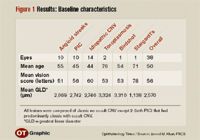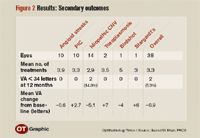Article
CNV due to uncommon causes responds variably to PDT
The best outcomes were achieved in patients with PIC, toxoplasmosis, Stargardt's disease, and birdshot choroidopathy, and the results were better than expected in eyes with angioid streaks.

Dr. Khan reported the results at the annual meeting of the Association for Research in Vision and Ophthalmology from 38 eyes of 37 consecutively seen patients at the St. Paul's Eye Unit, Royal Liverpool University Hospital, Liverpool, England, where he is specialist registrar. There were 10 eyes each with punctate inner choroid-opathy (PIC) and angioid streaks; CNV was idiopathic in 14 eyes, and associated with toxoplasmosis in two eyes. In addition, single eyes were affected by birdshot choroidopathy and Stargardt's disease.
Mean follow-up for the group post-enrollment was 17.3 months. Two eyes (5.3%) only reached the 9-month visit, but the duration of follow-up in the remaining eyes ranged from 12 to 36 months.

"Interpretation of these data is limited by our lack of controls, small numbers of patients, and short follow-up. Therefore, our next step will be a larger, longer-term study, and perhaps based on these results, a case might be made for a randomized, controlled trial in patients with idiopathic CNV for which the natural history is variable," he said.
"In addition, all patients receiving PDT in the United Kingdom are now being entered into a central database, which we hope will provide us with additional information on the response to PDT of these eyes with more uncommon causes of CNV," he said.

He noted as well that the visual prognosis is particularly poor for eyes with angioid streaks and PIC.
"According to published literature, most patients with angioid streaks are blind by age 50 and more than three-fourths of eyes with PIC have vision worse than 20/100 after a median of 3 years. Furthermore, neither of those conditions responds to confluent laser treatment," he said.
Younger patient population Patients eligible for enrollment had to meet inclusion/exclusion criteria similar to that of the TAP study. As expected, however, the patients turned out to be not only younger on average than patients with AMD, but also had better mean vision scores and lesions with smaller mean greatest linear diameters (GLD) compared with patients with AMD, Dr. Khan noted.
Newsletter
Don’t miss out—get Ophthalmology Times updates on the latest clinical advancements and expert interviews, straight to your inbox.




